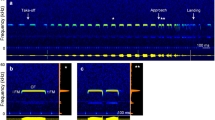Summary
Two species of Hipposiderid bats,Hiposideros speoris andH. lankadiva, which both emit short CF-FM echolocation calls, were trained in a two-alternative forced-choice procedure to discriminate between an oscillating target and a motionless one. Two different targets were used: (1) the membrane of a low-frequency loudspeaker, producing sinusoidal frequency- and amplitude modulations and (2) a small rotating propeller, which produced short acoustical ‘glints’. In both casesH. lankadiva learned to discriminate between the oscillating and the motionless target. When the loudspeaker was used, thresholds for minimal modulation depths at different oscillation frequencies were determined. At loudspeaker membrane oscillation frequencies of 10 to 100 Hz the 75% correct thresholds lay between 90 and 300 Hz (Fig. 3).H. speoris could not be trained to react to the moving membrane, even at very high oscillation amplitudes. When the rotating propeller was the positive target, however,H. speoris learned very quickly to discriminate it from a motionless one. By decreasing the rotation speed it was possible to measure the minimal detectable glint-frequency for each bat. It lay at 67, 44, and just under 15 glints/s for the three specimens (Fig. 4). During the discrimination task both bat species increased their duty-cycle just prior to a decision by emitting long sequences of echolocation calls with short inter-pulse intervals. The duration of individual pulses remained relatively constant (Figs. 6 and 7). Possible mechanisms for discrimination of the oscillating targets are discussed and the importance of ‘glints’ in the echoes for fluttering target detection is emphasized.
Similar content being viewed by others
Abbreviations
- A0 :
-
amplitude of loudspeaker membrane oscillation
- AM :
-
amplitude modulation
- CF :
-
constant frequency
- DC :
-
duty-cycle
- FM :
-
frequency modulation
- Δf max :
-
maximal frequency modulation depth in echo
- PD :
-
pulse duration
- PI :
-
pulse interval
- f osc :
-
oscillation frequency
References
Airapetianz ES, Konstantinov AI (1974) Echolocation in nature. Leningrad. English translation: Joint Publication Research Service, Arlington
Bell GP, Fenton MB (1984) The use of Doppler-shifted echoes as a clutter rejection system: the echolocation and feeding behavior ofHipposideros ruber (Chiroptera: Hipposideridae). Behav Ecol Sociobiol 15:109–114
Gellermann LW (1933) Chance disorders of alternating stimuli in visual discrimination experiments. J Genet Psychol 42:205–208
Goldman LJ, Henson OW Jr (1977) Prey recognition and selection by the constant frequency bat,Pteronotus parnellii. Behav Ecol Sociobiol 2:411–419
Griffin DR (1958) Listening in the dark. Yale University Press, New Haven
Heilmann U (1984) Das Frequenzunterscheidungsvermögen bei der großen Hufeisennase,Rhinolophus ferrumequinum. Dissertation, Universität Tübingen
Kober R (1982) Analyse des Ultraschallechos von einheimischen Insekten. Staatsexamensarbeit, Fakultät Biologie, Universität Tübingen
Neuweiler G (1983) Echolocation and adaptivity to ecological constraints. In: Huber F, Markl H (eds) Neuroethology and behavioral physiology. Springer, Berlin Heidelberg New York, pp 251–266
Novick A, Vaisnys JR (1964) Echolocation of flying insects by the batChilonycteris parnellii. Biol Bull 127:478–488
Pye JD (1967) Theories of sonar systems and their application to biological organisms (discussion). In: Busnel RG (ed) Animal sonar systems. Lab Physiol Acoust, CNRS Jouy-en-Josas, France, pp 1121–1136
Roeder KD (1963) Echos of ultrasonic pulses from flying moths. Biol Bull 124:100–120
Schnitzler HU (1970a) Echoortung bei der FledermausChilonycteris rubinosa. Z Vergl Physiol 68:25–39
Schnitzler HU (1970b) Comparison of the echolocation behavior inRhinolophus ferrumequinum andChilonycteris rubinosa. Bijdr Dierk 40:77–80
Schnitzler HU (1973) Control of Doppler shift compensation in the greater horseshoe bat,Rhinolophus ferrumequinum. J Comp Physiol 82:79–92
Schnitzler HU (1978) Die Detektion von Bewegungen durch Echoortung bei Fledermäusen. Verh Dtsch Zool Ges 1978, S 16–33
Schnitzler HU, Flieger E (1983) Detection of oscillating target movements by echolocation in the greater horseshoe bat. J Comp Physiol 135:385–392
Schnitzler HU, Henson OW Jr (1980) Performance of airborne animal sonar systems: I. Microchiroptera. In: Busnel RG, Fish JF (eds) Animal sonar systems. Plenum Press, New York, Nato advanced study institute series (A) 28:109–181
Schnitzler HU, Menne D, Kober R, Heblich K (1983) The acoustical image of fluttering insects in echolocating bats. In: Huber F, Markl H (eds) Neuroethology and behavioral physiology. Springer, Berlin Heidelberg New York, pp 235–250
Schnitzler HU, Hackbarth H, Heilmann U, Herbert H (1985) Echolocation behavior of rufous horseshoe bats hunting for insects in the flycatcher-style. J Comp Physiol A 157:38–46
Schnitzler HU, Menne D, Hackbarth H (1985) Range determination by measuring time delays in echolocating bats. In: Michelsen A (ed) Time resolution in auditory systems. (Proceedings of the 11th Danavox Symposium on Hearing, Garnie Avernaes, Denmark, August 28–31, 1984) Springer, Berlin Heidelberg New York, pp 180–204
Schuller G (1972) Echoortung beiRhinolophus ferumequinum mit frequenzmodulierten Lauten. J Comp Physiol 77:306–331
Schuller G, Beuter K, Schnitzler HU (1974) Response to frequency shifted artificial echoes in the batRhinolophus ferrumequinum. J Comp Physiol 89:275–286
Simmons JA (1973) The resolution of target range by echolocating bats. J Acoust Soc Am 54:157–173
Simmons JA (1979) Perception of echo phase information in bat sonar. Science 204:1336–1338
Trappe M (1982) Verhalten und Echoortung der Großen Hufeisennase beim Insektenfang. Dissertation, Universität Tübingen
Author information
Authors and Affiliations
Rights and permissions
About this article
Cite this article
von der Emde, G., Schnitzler, H.U. Fluttering target detection in Hipposiderid bats. J. Comp. Physiol. 159, 765–772 (1986). https://doi.org/10.1007/BF00603730
Accepted:
Issue Date:
DOI: https://doi.org/10.1007/BF00603730




